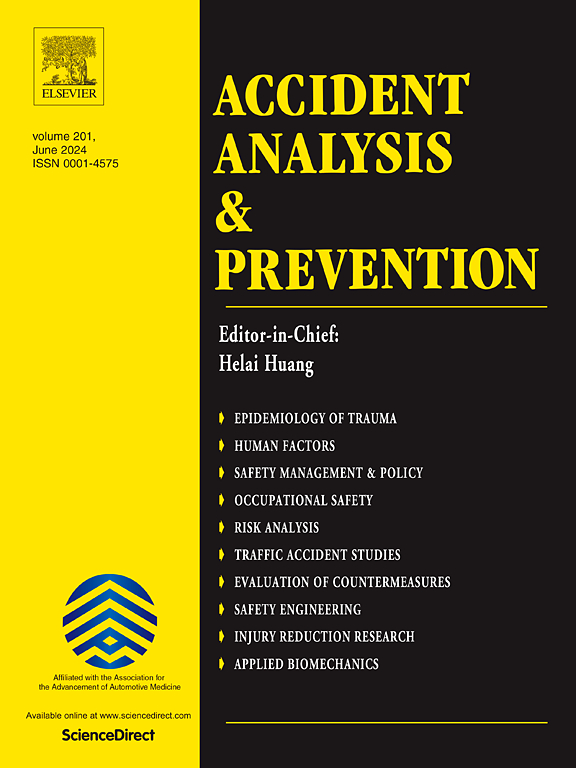探索夜间老年行人碰撞事故的模式。
IF 5.7
1区 工程技术
Q1 ERGONOMICS
引用次数: 0
摘要
由于老年人视力下降、反应时间变慢等与年龄相关的脆弱性,涉及老年人的夜间碰撞事故构成了重大的安全隐患。本研究使用关联规则挖掘(ARM)分析了德克萨斯州六年(2017-2022 年)的碰撞数据,以确定在不同照明条件下影响 65-74 岁和 74 岁以上老年行人碰撞严重程度的模式和关联。研究结果表明,高速限速和复杂的道路环境大大增加了这两个年龄组的行人遭受致命或严重伤害的风险,尤其是在照明不足的情况下。此外,人口因素、恶劣的天气条件和特定的道路特征也会进一步影响碰撞结果。这些洞察力凸显了采取干预措施的必要性,包括降低车速限制、加强街道照明以及采用现代行人检测系统、传感技术、行人安全袋、无障碍行人信号灯等先进技术,以改善老年行人的安全状况。政策制定者应利用这些见解来制定改善老年行人道路安全的战略,解决他们在各种夜间条件下的独特脆弱性。本文章由计算机程序翻译,如有差异,请以英文原文为准。
Exploring patterns in older pedestrian involved crashes during nighttime
Nighttime crashes involving older pedestrians pose a significant safety concern due to their age-related vulnerabilities such as reduced vision and slower reaction times. This study analyzes crash data from Texas for six years (2017–2022) using Association Rules Mining (ARM) to identify patterns and associations affecting crash severity for older pedestrians aged 65–74 years and those over 74 years under varying lighting conditions. The findings reveal that high-speed limits and complex road environments significantly increase the risk of fatal or severe injuries for both age groups, particularly under inadequate lighting. Additionally, demographic factors, adverse weather conditions, and specific road features further influence crash outcomes. These insights highlight the need for interventions, including lower speed limits, enhanced street lighting, and the implementation of advanced technologies such as modern pedestrian detection systems, sensor technology, pedestrian bags, accessible pedestrian signals, to improve the safety of older pedestrians. Policymakers should leverage these insights to formulate strategies that improve road safety for older pedestrians, addressing their unique vulnerabilities in various nighttime conditions.
求助全文
通过发布文献求助,成功后即可免费获取论文全文。
去求助
来源期刊

Accident; analysis and prevention
Multiple-
CiteScore
11.90
自引率
16.90%
发文量
264
审稿时长
48 days
期刊介绍:
Accident Analysis & Prevention provides wide coverage of the general areas relating to accidental injury and damage, including the pre-injury and immediate post-injury phases. Published papers deal with medical, legal, economic, educational, behavioral, theoretical or empirical aspects of transportation accidents, as well as with accidents at other sites. Selected topics within the scope of the Journal may include: studies of human, environmental and vehicular factors influencing the occurrence, type and severity of accidents and injury; the design, implementation and evaluation of countermeasures; biomechanics of impact and human tolerance limits to injury; modelling and statistical analysis of accident data; policy, planning and decision-making in safety.
 求助内容:
求助内容: 应助结果提醒方式:
应助结果提醒方式:


